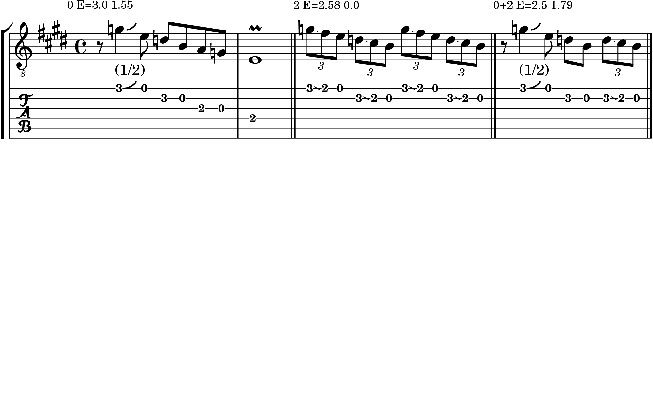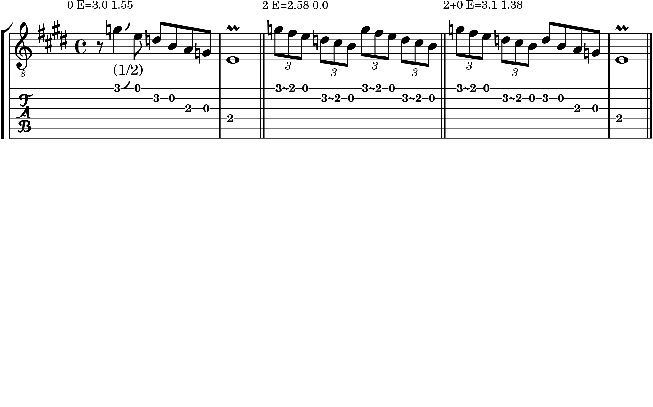Posted: Dec 01, 2015 4:49 pm
So far I've only demonstrated "cool" mutations. This class of mutations doesn't add any pitches to a lick that weren't already in it to begin with and the mutations start and stop on the original notes of the lick. This means that the mutation doesn't stray too far from the original lick. The scale, chord, key of the lick remains the same. Of course, that doesn't mean that we didn't "break" the lick in someway. I'm reminded of what Shrunk said early on in the thread.
Did the cool mutations I used ruin the fluency of the licks? If so, why? How would one determine such a thing?
Anyone who ever tried to play a musical instrument knows that it is possible to hit a note that doesn't play nice with the other notes you're playing - although Miles Davis might have disputed that. But the cool mutations avoid really klunker notes.
But now we move on to 'warm" mutations. This class of mutations has more creative freedom. All the notes don't have to be part of the original lick. And the lick doesn't have to stay it's original length - it can shrink or grow a bar. The main point is that the scale(s) and/or chord(s) of the lick could change - and that's a pretty big difference. And the starting-ending point of the lick can change- and that's a pretty big difference too.
Changing the chord/scale of the lick and where it starts and stops has a lot more potential for ruining the "fluency" of the lick- if that's actually a real thing that is possible to do. I mean - who decides such a thing. Are there blues lick gate keepers? And what rules do they follow? I'm reminded of the clip I posted earlier where Chuck Berry wasn't happy with how Keith Richards played his lick. And how Chuck insisted that Keith play it his way. Now I imagine that Keith has been playing that lick a certain way since he figured out how to play it off a Chuck Berry record - is there really something wrong with the lick Keith was using? Anybody have any ideas about this?
Anybody have any ideas about this?
The cool mutations were examples of asexual reproduction. That is, when a mutation occurred, a new one was created and the parent was left intact. Now we're getting to the good part - lick sex. These mutations take two licks and produce an offspring with bits from each parent lick. The way this works is that the front end of one lick is combined with the back end of another lick. The exact line defining front vs back is flexible. It shifts from offspring to offspring. But licks are confined to 1 or 2 bars in length.
Here's an example of two proud parent licks with their new baby. The beginning of lick 0 is combined with the end of lick 2

And another example.

That should give the idea of how my lick sex works. Licks can be defined originally to be asexual or just front ends or back ends, or both. Anyone have other ideas for good lick sex?
I took pretty much the original licks I've been using and let them spawn for a bit with each other. No cool mutations were introduced. Here's a pdf of the licks and their offspring.(the + shows which licks combined to produce the offspring). And here's what the licks sound like. I included the original licks up front followed by children - it's a bit hard to know exactly how to present this. I mostly want to give the feel for what kind of variety this can produce and also how the resulting licks can differ from cool mutations. It can be a bit hard to know where one lick ends and another begins if you're not following along with the music but even skipping around in the soundfile should give the idea of what lick sex is all about.
The analogy I would use is that the blues (or any other musical idiom) is a language. The chord structure is like the grammar and licks or riffs are like idiomatic phrases that identify a fluent speaker of the language from someone who can do no more than speak the language well enough to get his thoughts across, but not with fluency.
Did the cool mutations I used ruin the fluency of the licks? If so, why? How would one determine such a thing?
Anyone who ever tried to play a musical instrument knows that it is possible to hit a note that doesn't play nice with the other notes you're playing - although Miles Davis might have disputed that. But the cool mutations avoid really klunker notes.
But now we move on to 'warm" mutations. This class of mutations has more creative freedom. All the notes don't have to be part of the original lick. And the lick doesn't have to stay it's original length - it can shrink or grow a bar. The main point is that the scale(s) and/or chord(s) of the lick could change - and that's a pretty big difference. And the starting-ending point of the lick can change- and that's a pretty big difference too.
Changing the chord/scale of the lick and where it starts and stops has a lot more potential for ruining the "fluency" of the lick- if that's actually a real thing that is possible to do. I mean - who decides such a thing. Are there blues lick gate keepers? And what rules do they follow? I'm reminded of the clip I posted earlier where Chuck Berry wasn't happy with how Keith Richards played his lick. And how Chuck insisted that Keith play it his way. Now I imagine that Keith has been playing that lick a certain way since he figured out how to play it off a Chuck Berry record - is there really something wrong with the lick Keith was using?
The cool mutations were examples of asexual reproduction. That is, when a mutation occurred, a new one was created and the parent was left intact. Now we're getting to the good part - lick sex. These mutations take two licks and produce an offspring with bits from each parent lick. The way this works is that the front end of one lick is combined with the back end of another lick. The exact line defining front vs back is flexible. It shifts from offspring to offspring. But licks are confined to 1 or 2 bars in length.
Here's an example of two proud parent licks with their new baby. The beginning of lick 0 is combined with the end of lick 2

And another example.

That should give the idea of how my lick sex works. Licks can be defined originally to be asexual or just front ends or back ends, or both. Anyone have other ideas for good lick sex?
I took pretty much the original licks I've been using and let them spawn for a bit with each other. No cool mutations were introduced. Here's a pdf of the licks and their offspring.(the + shows which licks combined to produce the offspring). And here's what the licks sound like. I included the original licks up front followed by children - it's a bit hard to know exactly how to present this. I mostly want to give the feel for what kind of variety this can produce and also how the resulting licks can differ from cool mutations. It can be a bit hard to know where one lick ends and another begins if you're not following along with the music but even skipping around in the soundfile should give the idea of what lick sex is all about.